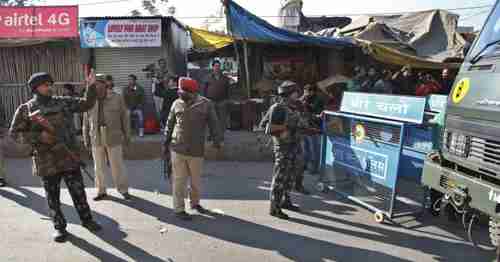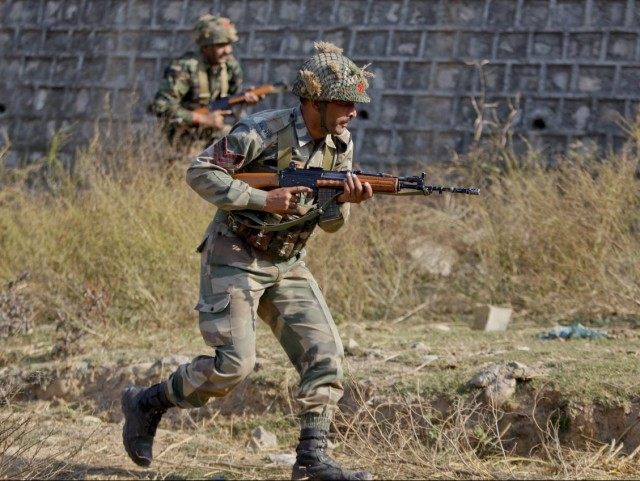This morning’s key headlines from GenerationalDynamics.com
- Terror attack on India’s Pathankot air base exposes weak defenses
- India threatens retaliation on Pakistan for the Pathankot attack
- Pathankot air base incident revives memories of the ’26/11′ Mumbai attack in 2008
Terror attack on India’s Pathankot air base exposes weak defenses

Aftermath of terror attack on Pathankot air base (AP)
Indians are in shock at how easily a terror group was able to infiltrate an Indian Air Force Base at Pathankot, in Punjab province near the border with Pakistan, for a devastating terror attack on January 2-3.
In retrospect, it seems like a comedy of errors.
India’s Border Security Force (BSF), which guards the international border between Punjab and Pakistan, at first had no clue that heavily armed terrorists had infiltrated the base from Pakistan. The terrorists evaded the BSF when they were discovered, but the BSF didn’t raise the alarm, thinking they were merely robbers.
Late on December 31, the terrorists grabbed Pathankot’s Superintendent of Police (SP), Salwinder Singh, blindfolded him and threw him out of his car, in which they fled. When Singh reported the incident, his seniors did not take him seriously, thinking that he had gotten drunk at a New Year’s Eve party. When they finally took him seriously, they had no idea where the terrorists had gone. The base has a sprawling perimeter with a circumference of 25km, and has nearly 10,000 families living there.
India’s National Security Guard (NSG) was activated, and gunfights between the terrorists began on January 1, and continued through the night into January 2. Three terrorists were killed, and the NSG thought the fight was over, but gunfights with the remaining terrorists began again later that day.
The terrorists had defeated every layer of protection that India had put in place to protect the Pathankot air base. The terrorists had managed to enter the air base undetected. They were already inside the base’s reinforced gates well before the NSG commandos took position. The terrorists had managed to evade the Border Security Force (BSF), the Punjab Police and the Guard and Defense Service Corps.
The Pathankot incident is being viewed as an index of the extraordinary weakness in the protection of the country’s critical strategic assets. The air force base constitutes the frontline air defense for any confrontation with Pakistan, and yet the terrorists succeeded in penetrating into the campus and inflicting significant casualties. This was despite nearly 20 hours of clear warning, a definitive identification of the intended target, and a systemic response that had been initiated fairly early on January 1, 2016, after central intelligence agencies picked up conversations by the terrorists with their handlers and their families, and the Punjab Police received specific information about their movements and intention from the ‘abducted’ Superintendent of Police whose car was used by the terrorists. Hindustan Times and South Asia Terrorism Portal (SATP – India)
India threatens retaliation for the Pathankot attack
The perpetrators are believed to be the Pakistan-based terror group Jaish-e-Mohammed, based on evidence collected by India, and passed on to Pakistani authorities.
India’s prime minister Narendra Modi had visited Pakistan’s prime minister Nawaz Sharif in the latter’s ancestral home near Lahore on December 25. (Neither Hindus nor Muslims celebrate Christmas.) The meeting was described as “very warm,” and held “amid immense goodwill in a very cordial atmosphere.”
Their meeting was part of the hallucinatory “peace process” talks that have been off and on for years, through many changes of government, but never getting anywhere. It is thought that Jaish-e-Mohammed may have conducted the Pathankot attack in order to, once again, derail the “peace process.”
There are certainly no “peace talks” planned now for any time soon. India’s defense minister Manohar Parrikar on Monday warned that India will get revenge on the perpetrators of the attack.
If someone is harming this country, then that particular individual or organization, I purposely used the words individual and organization, should also receive the pain of such activities. The time and place should be of our choosing.
Basic principle is that until we give them pain, whoever they may be, until then, such incidents will not reduce.
However, Parrikar did not respond to questions about whether that India is planning a retaliation attack on Jaish-e-Mohammed on Pakistani soil. New Delhi TV (25-Dec-2015) and Indian Express and India.com
Pathankot air base incident revives memories of the ’26/11′ Mumbai attack in 2008
The Pathankot incident is reviving bitter memories of the horrendous “26/11” terrorist attack on a number of hotels in Mumbai, India. The attacks began on November 26, 2008, and lasted three days, killing 166 people, and wounding hundreds more. ( “After Mumbai’s ’26/11′ nightmare finally ends, India – Pakistan relations face crisis” from 2008)
The attack was blamed on Lashkar-e-Taibi (LeT), a Pakistani terrorist group that was formed in the 1990s by Pakistan’s Inter-Services Intelligence (ISI) agency to fight India in the disputed regions of Kashmir and Jammu. After the attack, India threatened to send its army to attack LeT on Pakistani soil, which might have led to a major war. This was prevented by hard intervention by Secretary of State Condoleezza Rice.
Pakistan promised to pursue and prosecute LeT in its own courts. However, the alleged leader of the Mumbai attack, Zaki-ur-Rahman Lakhvi, has never been seriously prosecuted, presumably for fear of implicating some Pakistani government officials. Lakhvi is out on bail, and is now leader of Jamaat-ud-Dawa (JuD), which is a front group for LeT.
The Pathankot attack revives the same issues, particularly after Manohar Parrikar’s demands for retaliation, and the hinted possibility of Indian military action to pursue Jaish-e-Mohammed on Indian soil.
All the usual diplomatic moves are being played:
- India has handed over evidence to Pakistan that includes intercepts of phone calls allegedly made by the terrorists to their handlers in Pakistan. Ammunition and other equipment were also handed over to Pakistan.
- India has demanded that Pakistan act promptly and urgently to find and prosecute those behind the attack.
- Pakistan’s prime minister Nawaz Sharif has assured Narendra Modi that prompt and decisive action will be taken against those found guilty. However, Sharif is denying that either Pakistan’s government of the ISI had anything to do with the attack.
- Parts of Pakistan’s media are blaming the attack on India’s own intelligence services, the Research and Analysis Wing (RAW) to sabotage the dialogue process. They note that India had had some reports in advance warning of an attack, but that India’s security forces did nothing to prevent it.
- On Monday, Pakistan authorities reported that the phone numbers provided as evidence had been investigated, and were found to be unregistered and untraceable. Indian authorities reportedly consider that laughable, saying that Pakistan’s telecom rules do not allow phone numbers to be activated until registered.
Pakistani authorities have carried out raids and arrested an unspecified number of people. The arrests led Prime Minister Nawaz Sharif to order a joint investigation team of Intelligence Bureau(IB), Inter-Services Intelligence, Military Intelligence, Federal Investigation Agency and police to thoroughly probe the Pathankot attack links to Pakistan. Daily Times (Pakistan) and Daily Pakistan and Indian Express and Pakistan Today
KEYS: Generational Dynamics, India, Pathankot air base, Border Security Force, BSF, Salwinder Singh, National Security Guard, NSG, Narendra Modi, Nawaz Sharif, Jaish-e-Mohammed, Manohar Parrikar, Mumbai, 26/11, Lashkar-e-Taibi, LeT, Inter-Services Intelligence, ISI, Zaki-ur-Rahman Lakhvi, Jamaat-ud-Dawa, JuD, Research and Analysis Wing, RAW
Permanent web link to this article
Receive daily World View columns by e-mail

COMMENTS
Please let us know if you're having issues with commenting.